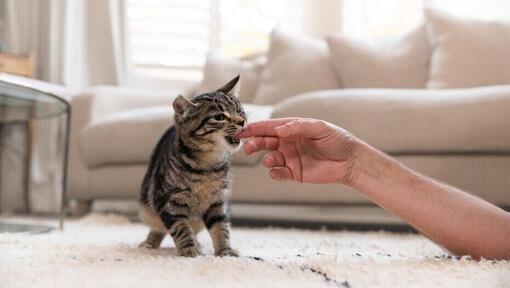Kissan aggressiivinen käytös toista kissaa kohtaan – syyt ja ratkaisut

Your cat probably has lots of quirky habits, which is one of the many reasons they’re so much fun to be with. But sometimes their behaviour can surprise you – maybe yours has been scratching and clawing things you don’t want them to, for example, or shredding an innocent pair of curtains. We often associate chewed-up furnishings and general mayhem with mischievous or anxious dogs, but a destructive pet with cat behaviour problems can do their fair share of damage too.
As cats have evolved to be top-of-the-food-chain predators, aggression is an integral part of their behaviour. Cats use aggression for lots of reasons, such as catching and killing prey, defending themselves and their territory, and warding off competitors.
Hopefully your cat shouldn’t show aggression towards you at home, but if they do there are certain things you can do to understand and resolve any issues.
Kissallasi on luultavasti useita kummallisia tapoja, mikä on yksi monista syistä miksi kissat ovat niin viihdyttäviä. Mutta joskus heidän käytöksensä voi yllättää sinut – ehkä kissasi on esimerkiksi raapinut huonekaluja, tai repinyt verhoja. Ajattelemme usein pureskeltujen esineiden tai yleisen sekasorron liittyvän viekkaisiin tai ahdistuneisiin koiriin, mutta myös käyttäytymisongelmainen kissa voi aiheuttaa vahinkoa.
Koska kissat ovat kehittyneet ravintoketjun huipulla oleviksi petoeläimiksi, aggressio on olennainen osa niiden käyttäytymistä. Kissat käyttävät aggressiota monista syistä, kuten saaliin pyydystämiseksi ja tappamiseksi, itsensä ja reviirinsä puolustamiseksi ja kilpailijoiden karkottamiseksi.
Toivottavasti kissasi ei osoita aggressiota sinua kohtaan kotona, mutta jos näin on, on muutama asia joita voit tehdä ymmärtääksesi ja ratkaistaksesi ongelmat.
Miksi kissani on aggressiivinen?
Jos kissasi on aggressiivinen, on syytä pohtia miksi. Onko se peloissaan tai huolissaan jostakin? Onko sillä kipuja? Puolustaako se reviiriään? Leikkiikö se vain liian innokkasti? Kissan aggressiiviselle käytökselle on monia mahdollisia syitä.
Joskus aggressiivinen käytös on tilapäistä ja olosuhteiden aiheuttamaa (ehkä kissasi on juuri törmännyt viholliskissaan), kun taas joskus se on enemmän sisäänrakennettua ja kissasi persoonallisuuteen liittyvää – esimerkiksi sosiaalisuuden puute nuorella iällä on yleinen syy aggressiivisuuteen.
On aina hyvä idea viedä kissasi eläinlääkäriin tarkastettavaksi, siltä varalta että aggressiivinen käytös johtuisi kivusta tai muusta sairaudesta (kuten esimerkiksi neurologisista häiriöistä). Kivun aiheuttama aggressio on yleistä, joten jos eläinlääkäri voi tehdä kissasi olosta mukavamman, se todennäköisesti on paljon vähemmän ärtyisä.
Mitä tehdä jos kissasi puree sinua?
Vaikka oman aggressiivisen kissan raapaisu tai purema voi tulla järkytyksenä, yritä pysyä rauhallisena. Huutaminen, äkkinäiset liikkeet ja fyysinen rankaisu vain pelottavat kissaasi ja saavat sen karsastamaan huomiota entisestään.
Pese naarmut tai puremajäljet heti lämpimällä saippuavedellä ja levitä päälle antiseptistä voidetta. Tarvittaessa hakeudu lääkärin hoitoon.
Sopimattomat saalistuskohteet
Leikkiessä kissasi näkee lelunsa ”saaliina”, joten älä koskaan leikitä kissaasi omilla paljailla käsilläsi tai voit päätyä hyökkäyksen tai raapimisen kohteeksi. Käytä sen sijaan onkimaista huiskalelua tai kauko-ohjattavaa lelua, jotta voit leikkiä lemmikkisi kanssa turvallisen välimatkan päästä.
Metsästysleikit voivat olla yleisiä sisäkissoilla, joilla on rajalliset mahdollisuudet ilmaista luonnollista saalistuskäyttäytymistään. Siksi ne saattavat joskus väijyä oven takana ja törmätä sinuun ohittaessasi. Kuten useimmat kissan käyttäytymisongelmat, on parasta jättää se huomiotta.
Pysy paikallasi, älä reagoi. Jos et tee mitään, kissasi menettää kiinnostuksensa. Jos epäilet, että se hyökkää kimppuusi, ohjaa kissasi huomio muualle kierittämällä lattialle lelun jota he voivat jahdata.
Joskus kun kissasi näyttää kiinnittyneen toiseen eläimeen tai esineeseen, kuten linnun katseluun ikkunan läpi, voit selvästi nähdä sen kehonkielestä että se on siirtynyt "petoeläintilaan". Puhumalla kissalle rauhoittavalla äänellä voit saada sen pois keskittyneestä tilastaan, tai voit yrittää kierittää paperipallon kissan ohitse hämätäksesi sen huomion turvallisesti.
Kissan käyttäytymisongelmat, jotka liittyvät aggressioon
On olemassa useita skenaarioita, jotka saavat voivat saada kissan reagoimaan aggressiivisesti. On tärkeää tunnistaa, minkä tyyppisestä aggressiosta on kyse, jotta voit yrittää löytää sopivan ratkaisun. Alla on kuvailtu yleisimmät tyypit. On kuitenkin tärkeää muistaa, että tilanne voi olla vaarallinen, joten jos kisssasi on aggressiivinen, on hyvä jutella asiasta eläinlääkärin kanssa.
Leikkiin liittyvää aggressiota esiintyy useammin kuin uskotkaan. Joissakin tapauksissa se voi aiheuttaa vammoja ihmisille, ja se voi sisältää vainoamista, puremista, raapimista, tai hyökkäämistä. Kissasi saattaa muuttua aggressiiviseksi leikin aikana, jos se on alistimuloitu tai jos sillä on liikaa energiaa josta se yrittää päästä eroon liiallisella aktiivisuudella tai vihamielisyydellä.
Kissaemon aggressio
Kaikkien äitien tiedetään suojelevan jälkeläisiään voimakkaasti, kissat mukaan lukien. Emon aggressio tapahtuu, kun kissa havaitsee uhan ja kokee kissanpennun olevan vaarassa. Normaalisti tämä tapahtuu muiden eläinten läsnä ollessa, mutta joskus se voi kohdistua myös ihmisiin. Emon aggression ei kuitenkaan tulisi kestää yli kolme-neljä viikkoa, joka on aika jolloin vastasyntyneet kissanpennut ovat haavoittuvimpia.
Saalistajan aggressio
Kissoilla on saalistusvaistoja, ja vaikka se näkyy yleensä muita eläimiä ja lintuja kohtaan, jotkut väittävät että se voi kohdistua myös ihmisiin. On kuitenkin epätodennäköistä, että kissat näkevät meidät potentiaalisena saaliina suuren kokomme vuoksi (kissat metsästävät yleensä paljon itseään pienempiä saaliita). Jos he yrittävät "metsästää" meitä, se johtuu yleensä siitä, että he leikkivät käsillämme tai jaloillamme - eivät siksi, että heillä on todellinen aikomus metsästää ja saalistaa meidät.
Kuten aiemmin mainittiin, jos kissa kuitenkin piiloutuu ja hyökkää hiljaa kävellessäsi sen ohi, tai yrittää purra käsiäsi tai jalkojasi joka kerta kun liikutat niitä, kysy neuvoa käyttäytymiseen erikoistuneelta eläinlääkäriltä.
Kosketukseen liittyvä aggressio
Kaikki kissat eivät pidä silittelystä; jotkut voivat jopa kokea sen epämiellyttävänä tai pelottavana. Kiinnitä erityistä huomiota kissasi käyttäytymiseen aina, kun yrität silittää sitä ja huomaa miten kissasi reagoi. Ehkä se nauttii vain päänsä tai selkänsä silityksestä, joten vältä koskettamasta muita kehon osia, jotka voivat laukaista jopa aggressiivista käytöstä.
Ruoka-aggressio kissoilla
Kissat osoittavat tällaista aggressiota muita eläimiä tai ihmisiä kohtaan, jotka saattavat tulla liian lähelle heidän ruokaansa. Näissä tapauksissa kissasi näkee muut uhkana ja tekee parhaansa pitääkseen heidät loitolla murisemalla, sähisemällä tai jopa hyökkäämällä. Syöminen muiden lemmikkien tai ihmisten seurassa voi aiheuttaa stressiä ja ahdistusta, joten paras ratkaisu on laittaa kissasi ruoka suojaiseen paikkaan, jossa se voi tuntea olonsa turvalliseksi. On kuitenkin tärkeää korostaa, että kissoilla tämä on harvinaisempaa kuin koirilla. Kissat ovat sosiaalisten ominaisuuksiensa vuoksi vähemmän kilpailukykyisiä ruoan suhteen.
Aggressio johtuen varhaisen sosialisoinnin puutteesta
Kuten otsikko kertoo, kissat joita ei ole sosialisoitu kunnolla kissanpentuina voivat kehittyä aggressiivisemmiksi. Tässä tapauksessa kyseessä on pelkoon liittyvä aggressio. Jos perheessäsi on useita lemmikkejä ja haluat esitellä tällaisen kissan heille, paras tapa tehdä tämä on esitellä se asteittain muille, yksitellen. Ajan myötä kissasi voi oppia, ettei ole mitään syytä pelätä ja suojautua.
Pelkoon liittyvä aggressio
Jotkut eläimet reagoivat pelkoon osoittamalla aggressiota. Tämä tuo heille hallinnan tunteen - puolustusmekanismin joka on auttanut heitä selviytymään lajina. He litistävät korvansa, näyttävät hampaansa, sähihisevät ja jopa hyökkäävät, varsinkin jos heillä ei ole pakotietä. Kun näin tapahtuu, kissasi saattaa jostakin syystä tuntea olevansa uhattuna, joten yritä tunnistaa syy ja varmistaa, että kissasi tuntee olonsa turvalliseksi. Turvallisen alueen luominen, jonne kissa voi hakeutua, voi olla erittäin hyödyllinen hyökkäysten estämisessä. Toisin sanoen kissalle tulee antaa mahdollisuus piiloutua ja välttää konfliktitilanteita, jos se katsoo sen tarpeelliseksi.
Aggressiivisuus talon muita kissoja kohtaan
Kissat osaavat olla varsin yksinäisiä olentoja, mutta yleensä ne tulevat hyvin toimeen muiden kissaperheenjäsenten kanssa. Monet kissat ovat hyvin helliä ja rakastavia lajitovereitaan kohtaan, kun taas toiset oppivat sietämään muita ja jättämään toisensa rauhaan, kunhan siihen vain on tarpeeksi tilaa. Jos asuintila on kuitenkin pieni, riitoja voi kehittyä useammin.
Kissat eivät yleensä ole vastakkainasettelevia, ja uhkaavissa tilanteissa ne mielummin pakenevat. Joten jos sinulla on useampi kuin yksi kissa, varmista, että kotiympäristössä on runsaasti korkealla olevia pakoreittejä, kuten kissan toimintakeskukset ja siistit ikkunalaudat, jonne ne voivat vetäytyä tarpeen tullen. Mikäli tilaa on, voi useamman kissan talouksissa olla erittäin hyödyllistä käyttää mikrosirulla varustettua kissanovea, jolloin jokainen kissa pääsee vain heidän omalle turvalliselle alueelleen. Tällä tavalla ympäristön hallinta annetaan itse kissoille, mikä vähentää aggressiota niiden keskuudessa.
Aivan kuten ihmismaailmassa, myös lemmikkien keskuudessa on kuitenkin erilaisia persoonallisuuksia, ja jotkut kissat eivät yksinkertaisesti pidä kotinsa jakamisesta muiden kanssa. Tai ne saattavat pitävää vain yksittäisestä kissasta. Näissä tapauksissa käyttäytymisasiantuntijan neuvoista voi olla apua, vaikka joskus uuden kodin löytäminen yhdelle kissoista on turvallisin ja oikeudenmukaisin vaihtoehto kaikille.
Varaa aikaa ja kärsivällisyyttä uuden kissan tuomisessa taloon. Älä koskaan huuda tai rankaise kissaasi, jos se ei ole erityisen vieraanvarainen, koska tämä voi johtaa negatiivisiin assosiaatioihin. Anna kissoille aikaa ja tilaa tottua uuteen toveriinsa, ja kysy tarvittaessa neuvoa elänlöökäriltä tai kissan käyttäytymisterapeutilta.
Aggressiivisuus naapuruston kissoja kohtaan
Tavallisesti leikkaamattomat kollikissat suhtautuvat naapuruston muihin kissoihin aggressiivisemmin, sillä ne osaavat olla hyvinkin reviiritietoisia ja kilpailuhenkisiä. Onneksi suurin osa leikatuista kissoista elää tyytyväisenä yhdessä tai ainakin oppii sietämään toisiaan! Kissat pyrkivät välttämään fyysistä kontaktia niin paljon kuin mahdollista, ja turvautuvat ensisijaisesti uhkailuun ja naukumiseen neuvottellessaan reviireistään.
Kaupunkialueilla, joilla tilaa on vähemmän, kissat voivat joutua iskuihin odottaessaan saman tilan käyttöä. Yritä tässä tapauksessa keskustella naapureiden kanssa nähdäksesi, voitko järjestää kissojen ulkoilun eri aikoina, jotta niiden tiet eivät risteäisi. On myös hyvä idea päästää kissasi ulos vasta ruokailun jälkeen, jotta ne ovat tyytyväisempiä.
Uudelleen suunnattu aggressio
Kissojen uudelleen suunnattu aggressio voi olla vakava ongelma, koska se on yleensä erittäin voimakasta. Kun kissa on syystä tai toisesta motivoitunut hyökkäämään, mutta ei voi tehdä sitä esimerkiksi siksi että joku pitelee sitä tai välissä on este, se saattaa suunnata aggressiivuutensa ihmisiä tai muita eläimiä kohtaan. Näin voi tapahtua, kun kissa näkee toisen kissan ikkunasta tai jopa silloin, kun kuuluu äkillinen ja kova ääni (ukkonen, ilotulitus jne). Tässä tapauksessa kissa ei pääse käsiksi melun lähteeseen, koska se on aineeton.
Usein kun kissa ohjaa aggressiota henkilöä kohti, se voi ylläpitää aggressiivisuuttaan pidemmän aikaa. Siksi on tärkeää, että jos kissa on aggressiivinen tai ärtyisä, et yritä koskettaa sitä. On parempi odottaa, kunnes se rentoutuu, ennen kuin olet vuorovaikutuksessa kissasi kanssa.



















